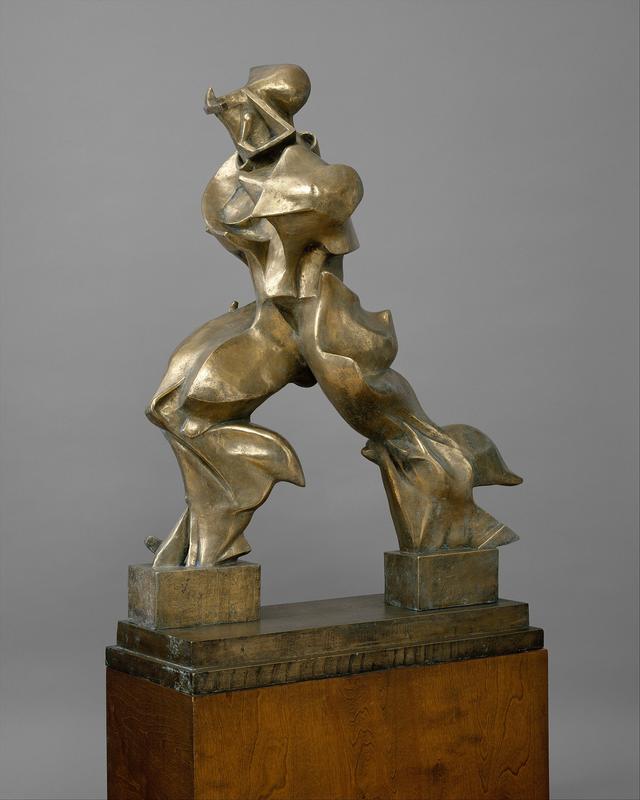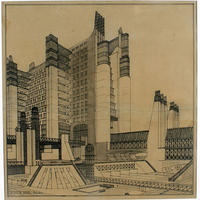More about Unique Forms of Continuity in Space
- All
- Info
- Shop

Contributor
Umberto Boccioni’s sculpture Unique Forms of Continuity in Space is the epitome of the idiom out with the old, in with the new!
The year was 1909 when a group of Italian artists got together and decided that the world needed a facelift, and the arts were no exception. “We are living in a modern time, why be stuck in the archaic past” reasoned this group. Sure the Italians hit it out of the park with the Renaissance and all, but it was time to move on and create something fresh. Naturally they decided to pump out a manifesto to legitimize their claim that they were going to become the new hot Italian art movement. Fittingly they dubbed themselves the Futurists. Technology and urban modernity was their thing and they aimed to portray this by capturing the lightning fast movement of the modern world.
Many artists during this time were rebelling against the art of yore, which generally depicted a lot of naked people lounging around. Artists were resisting the classical static pose and rather were embracing the ideal that since people move, art should represent that. Frustrated by the constraints of the canvas, Boccioni felt that through sculpture he could better convey the concepts of movement and fluidity that the Futurists valued so much.
This figure is literally striding into the future thus making the perfect representation of the Futurist ideals. On the other hand, this is not so much a sculpture of a person, but rather a sculpture of the movement of a person. In fact, Boccioni found the inspiration for this piece by watching the perfect movement of a football player.
Just one year after this work was created, World War I erupted. While most people see war as simply not that cool, the Futurists celebrated this anarchy for they believed that technological warfare would shatter Italy's obsession with their classical past. Of course Boccioni ended up dying in battle during this war, crushed under the movement of a skittish cavalry horse - irony at its finest.
This sculpture is the most iconic work to come out of the Futurist movement and is undoubtedly Boccioni’s masterpiece. This explains why the work you see in front of you is actually a reproduction of the original sculpture. Boccioni actually created this sculpture out of plaster and since his death it has been cast to produce the bronze reproductions found throughout museums today. In fact, Boccioni loathed bronze and felt his art should be destroyed when new innovative artists came to fruition. A slap in the face to Boccioni? Sure, but it allows all of us art nerds to soak in the beauty of his iconic masterpiece; replica or not. Italians are so proud of this sculpture and the avant-garde movement it came from that it is now featured on the Italian 20-cent Euro coin. As endearing as that is, I bet if Boccioni was here to see that, he would be pissed that Italy is still relishing their past.
Sources
- "Unique Forms of Continuity in Space" The Met's Heilbrunn Timeline of Art History. Accessed May 25, 2017. http://www.metmuseum.org/toah/works-of-art/1990.38.3/.
- McKever, Rosalind. "Umberto Boccioni, Unique Forms of Continuity in Space." Khan Academy. Accessed May 25, 2017. https://www.khanacademy.org/humanities/art-1010/wwi-dada/art-great-war/….
- McKever, Rosalind. "Harnessing the future: the art of Umberto Boccioni." Apollo Magazine. July 23, 2016. Accessed August 08, 2017. https://www.apollo-magazine.com/harnessing-the-future-the-art-of-umbert….
- Martinique, Elena. "All You Need to Know About Boccioni's Unique Forms of Continuity in Space." WideWalls. Accessed May 25, 2017. http://www.widewalls.ch/unique-forms-of-continuity-in-space/.
- Glueck, Grace. "Blurring the Line Between the Present and the Future." The New York Times. February 12, 2004. Accessed May 25, 2017. http://www.nytimes.com/2004/02/13/arts/art-review-blurring-the-line-bet….
- "Futurism Movement, Artists and Major Works." The Art Story. Accessed May 25, 2017. http://www.theartstory.org/movement-futurism-artworks.htm#pnt_4.
- "Futurism." The Art Story. Accessed May 25, 2017. http://www.theartstory.org/movement-futurism.htm.















